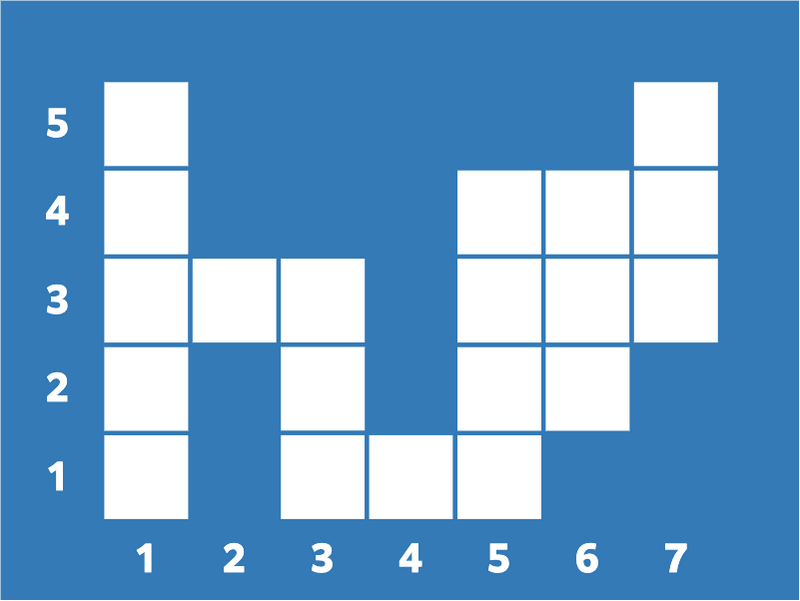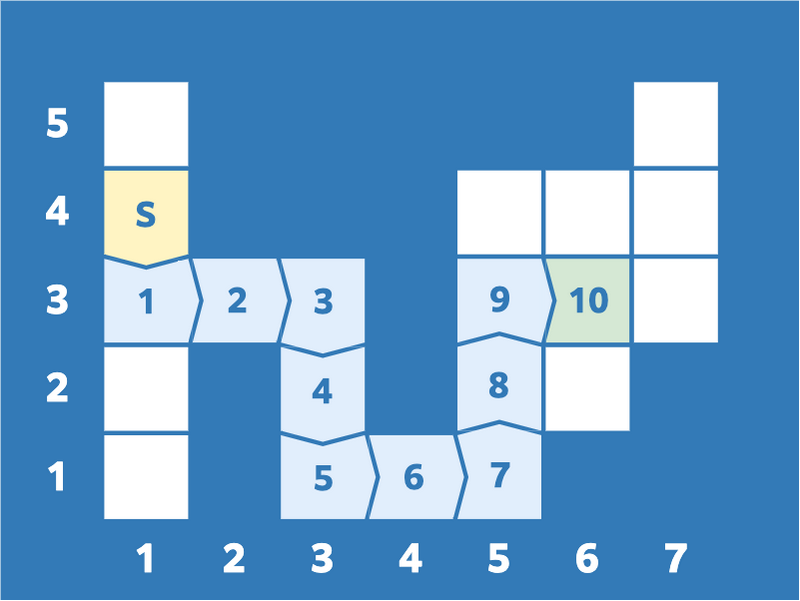10935: ABC365 - F - Takahashi on Grid
[Creator : ]
Description
There are infinitely many cells on a plane. For every pair of integers $(x,y)$, there is a corresponding cell, which we will call cell $(x,y)$.
Each cell is either an empty cell or a wall cell.
You are given two sequences of positive integers of length $N$: $L=(L _ 1,L _ 2,\dotsc,L _ N)$ and $U=(U _ 1,U _ 2,\dotsc,U _ N)$. Here, $L _ i$ and $U _ i$ satisfy $1\leq L _ i\leq U _ i\leq10 ^ 9$ for $i=1,2,\ldots,N$.
All cells $(x,y)\ (1\leq x\leq N,L _ x\leq y\leq U _ x)$ are empty cells, and all other cells are wall cells.
When Takahashi is at an empty cell $(x,y)$, he can perform one of the following actions.
- If cell $(x+1,y)$ is an empty cell, move to cell $(x+1,y)$.
- If cell $(x-1,y)$ is an empty cell, move to cell $(x-1,y)$.
- If cell $(x,y+1)$ is an empty cell, move to cell $(x,y+1)$.
- If cell $(x,y-1)$ is an empty cell, move to cell $(x,y-1)$.
It is guaranteed that he can travel between any two empty cells by repeating his actions.
Answer $Q$ queries in the following format.
For the $i$\-th query $(1\leq i\leq Q)$, you are given a quadruple of integers $(s _ {x,i},s _ {y,i},t _ {x,i},t _ {y,i})$. Find the minimum number of actions required for Takahashi to move from cell $(s _ {x,i},s _ {y,i})$ to cell $(t _ {x,i},t _ {y,i})$. For each query, it is guaranteed that the given two cells are empty cells.
Each cell is either an empty cell or a wall cell.
You are given two sequences of positive integers of length $N$: $L=(L _ 1,L _ 2,\dotsc,L _ N)$ and $U=(U _ 1,U _ 2,\dotsc,U _ N)$. Here, $L _ i$ and $U _ i$ satisfy $1\leq L _ i\leq U _ i\leq10 ^ 9$ for $i=1,2,\ldots,N$.
All cells $(x,y)\ (1\leq x\leq N,L _ x\leq y\leq U _ x)$ are empty cells, and all other cells are wall cells.
When Takahashi is at an empty cell $(x,y)$, he can perform one of the following actions.
- If cell $(x+1,y)$ is an empty cell, move to cell $(x+1,y)$.
- If cell $(x-1,y)$ is an empty cell, move to cell $(x-1,y)$.
- If cell $(x,y+1)$ is an empty cell, move to cell $(x,y+1)$.
- If cell $(x,y-1)$ is an empty cell, move to cell $(x,y-1)$.
It is guaranteed that he can travel between any two empty cells by repeating his actions.
Answer $Q$ queries in the following format.
For the $i$\-th query $(1\leq i\leq Q)$, you are given a quadruple of integers $(s _ {x,i},s _ {y,i},t _ {x,i},t _ {y,i})$. Find the minimum number of actions required for Takahashi to move from cell $(s _ {x,i},s _ {y,i})$ to cell $(t _ {x,i},t _ {y,i})$. For each query, it is guaranteed that the given two cells are empty cells.
Input
The input is given from Standard Input in the following format:
```
$N$
$L _ 1$ $U _ 1$
$L _ 2$ $U _ 2$
$\vdots$
$L _ N$ $U _ N$
$Q$
$s _ {x,1}$ $s _ {y,1}$ $t _ {x,1}$ $t _ {y,1}$
$s _ {x,2}$ $s _ {y,2}$ $t _ {x,2}$ $t _ {y,2}$
$\vdots$
$s _ {x,Q}$ $s _ {y,Q}$ $t _ {x,Q}$ $t _ {y,Q}$
```
```
$N$
$L _ 1$ $U _ 1$
$L _ 2$ $U _ 2$
$\vdots$
$L _ N$ $U _ N$
$Q$
$s _ {x,1}$ $s _ {y,1}$ $t _ {x,1}$ $t _ {y,1}$
$s _ {x,2}$ $s _ {y,2}$ $t _ {x,2}$ $t _ {y,2}$
$\vdots$
$s _ {x,Q}$ $s _ {y,Q}$ $t _ {x,Q}$ $t _ {y,Q}$
```
Output
Print $Q$ lines. The $i$-th line $(1\leq i\leq Q)$ should contain the answer to the $i$-th query.
Constraints
- $1\leq N\leq2\times10 ^ 5$
- $1\leq L _ i\leq U _ i\leq10 ^ 9\ (1\leq i\leq N)$
- $\lbrack L _ i,U _ i\rbrack\cap\lbrack L _ {i+1},U _ {i+1}\rbrack\neq\emptyset\ (1\leq i\lt N)$
- $1\leq Q\leq2\times10 ^ 5$
- $1\leq s _ {x,i}\leq N$ and $L _ {s _ {x,i}}\leq s _ {y,i}\leq U _ {s _ {x,i}}\ (1\leq i\leq Q)$
- $1\leq t _ {x,i}\leq N$ and $L _ {t _ {x,i}}\leq t _ {y,i}\leq U _ {t _ {x,i}}\ (1\leq i\leq Q)$
- All input values are integers.
- $1\leq L _ i\leq U _ i\leq10 ^ 9\ (1\leq i\leq N)$
- $\lbrack L _ i,U _ i\rbrack\cap\lbrack L _ {i+1},U _ {i+1}\rbrack\neq\emptyset\ (1\leq i\lt N)$
- $1\leq Q\leq2\times10 ^ 5$
- $1\leq s _ {x,i}\leq N$ and $L _ {s _ {x,i}}\leq s _ {y,i}\leq U _ {s _ {x,i}}\ (1\leq i\leq Q)$
- $1\leq t _ {x,i}\leq N$ and $L _ {t _ {x,i}}\leq t _ {y,i}\leq U _ {t _ {x,i}}\ (1\leq i\leq Q)$
- All input values are integers.
Sample 1 Input
7
1 5
3 3
1 3
1 1
1 4
2 4
3 5
3
1 4 6 3
1 4 1 1
7 5 1 5
Sample 1 Output
10
3
14
The given cells are as follows.

For the first query, for example, Takahashi can move from cell $(1,4)$ to cell $(6,3)$ in ten actions as follows.

It is impossible to move from cell $(1,4)$ to cell $(6,3)$ in nine or fewer actions, so print $10$.
Sample 2 Input
12
1 1000000000
1000000000 1000000000
1 1000000000
1 1
1 1000000000
1000000000 1000000000
1 1000000000
1 1
1 1000000000
1000000000 1000000000
1 1000000000
1 1
1
1 1 12 1
Sample 2 Output
6000000005
Sample 3 Input
10
1694 7483
3396 5566
2567 6970
1255 3799
2657 3195
3158 8007
3368 8266
1447 6359
5365 8614
3141 7245
15
3 3911 6 4694
7 5850 10 4641
1 5586 6 4808
2 3401 8 2676
3 3023 6 6923
8 4082 3 6531
6 3216 7 6282
8 5121 8 3459
8 4388 1 6339
6 6001 3 6771
10 5873 8 5780
1 6512 6 6832
8 5345 7 4975
10 4010 8 2355
7 5837 9 6279
Sample 3 Output
2218
1212
4009
1077
3903
4228
3067
1662
4344
6385
95
6959
371
4367
444